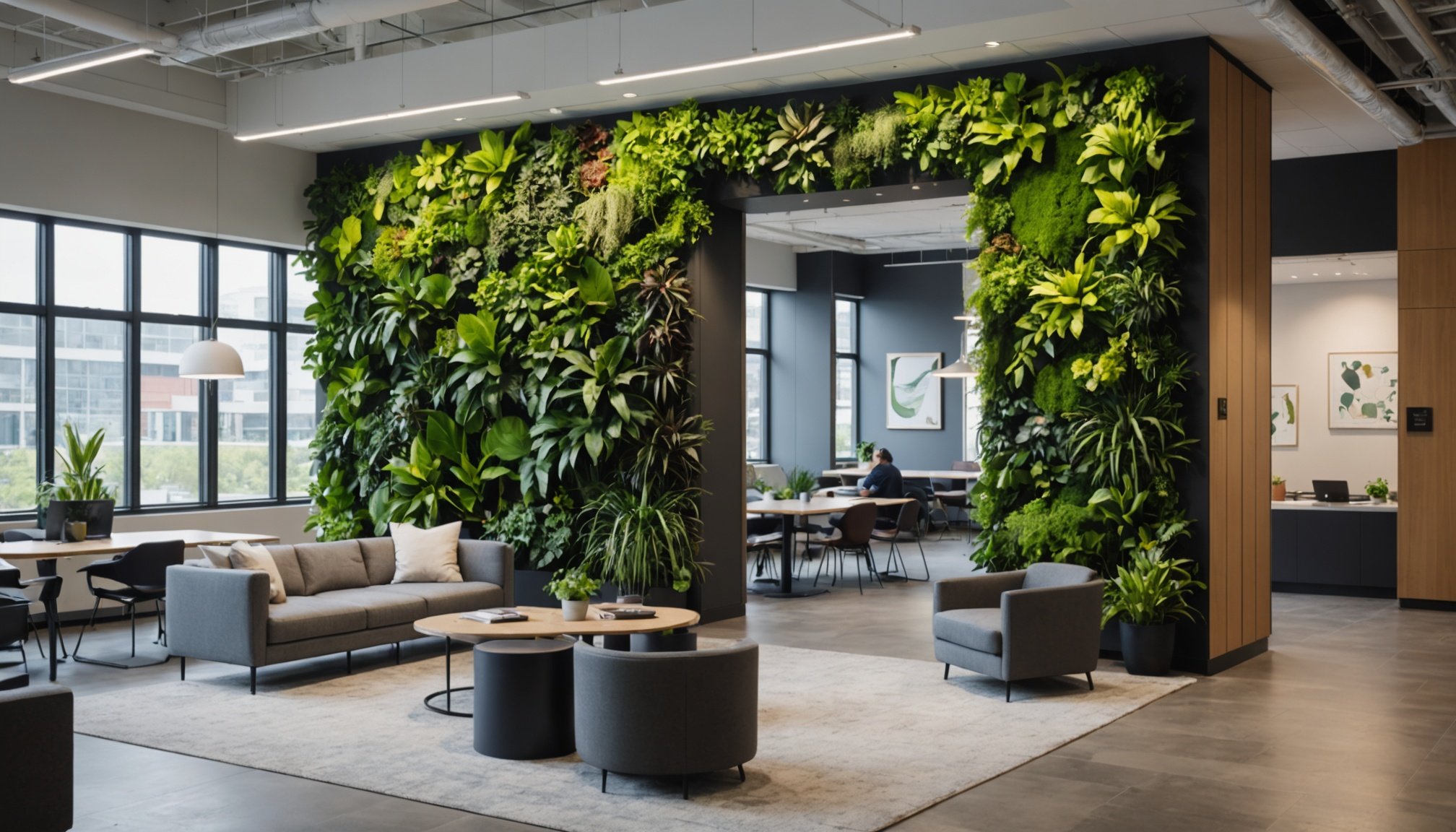Unlocking Employee Wellness: The Impact of Biophilic Design in the Workplace
In the modern workplace, the well-being of employees is more crucial than ever. With the majority of people spending up to 93% of their time indoors, the need to bring the natural world into our work environments has become a priority. This is where biophilic design comes into play, a concept that integrates nature into architecture and interior spaces to enhance employee wellness, productivity, and overall job satisfaction.
What is Biophilic Design?
Biophilic design, a term that translates to “love of life” from Greek, is rooted in the idea that humans have an innate attraction to nature. This concept, popularized by biologist Edward O. Wilson in the 1980s, involves incorporating natural elements, materials, and patterns into built environments to foster a connection with the natural world[1][2][4].
In the same genre : Unlocking Minds and Building Connections: The Surprising Benefits of Frequent Live Theater Attendance
In a workplace context, biophilic design is more than just adding plants or a few natural elements; it is a holistic approach to creating spaces that promote health, well-being, and productivity. This design philosophy includes various elements such as natural light, water features, green spaces, and natural materials like wood, bamboo, and stone.
Mental Health Benefits
One of the most significant advantages of biophilic design is its impact on mental health. Studies have shown that exposure to nature can significantly reduce mental health problems. For instance, a study by Aarhus University in Denmark found that children exposed to more nature have 55% fewer mental health problems later in life compared to those who are not[1].
In the same genre : Unlocking Healing: Narrative Therapy’s Transformative Effect on PTSD Recovery in Veterans – An In-depth Study
In an office setting, incorporating biophilic elements can improve well-being by 13% and productivity by 8%. A survey highlighted that the top three most desired elements in the workplace are natural light (44%), indoor plants (20%), and a view of the sea (17%)[1].
Here are some key mental health benefits of biophilic design:
- Reduced Stress: Being in nature or even just viewing natural scenes can lower cortisol levels, blood pressure, and pulse rate.
- Improved Mood: Natural environments can boost mood and reduce symptoms of depression and anxiety.
- Enhanced Cognitive Function: Exposure to nature has been shown to improve cognitive performance, including better concentration and creativity.
Physical Health Benefits
Biophilic design also has a positive impact on physical health. Research has identified several benefits, including:
- Lower Cortisol Levels: Reduced stress levels can lead to lower cortisol levels, which can help in managing chronic diseases.
- Improved Pain Tolerance: Studies have shown that patients in hospitals with natural views recover faster from surgery and have better pain tolerance[1].
- Better Air Quality: Incorporating plants and natural ventilation systems can improve air quality, reducing the risk of respiratory diseases.
Improved Sustainability
Biophilic design is not just beneficial for human health; it also supports sustainability. By incorporating natural elements and materials, biophilic design aligns with the United Nations’ Sustainable Development Goals (SDGs). Here are some ways biophilic design contributes to sustainability:
- Greater Air Quality: Plants and natural ventilation systems improve air quality.
- Optimised Thermal Comfort: Natural materials and green spaces can regulate temperature, reducing the need for heating and cooling.
- Improved Water Management: Green roofs and rain gardens can manage water runoff more effectively.
- Increased Building Lifespans: Sustainable materials and design principles can extend the lifespan of buildings[1].
Practical Implementation of Biophilic Design
Implementing biophilic design in the workplace is more accessible than you might think. Here are some practical ways to bring nature into your office space:
Incorporate Natural Light
Natural light is one of the most powerful biophilic elements. Here are a few ways to maximize natural light in your office:
- Large Windows: Install large windows to allow natural light to flood the space.
- Skylights: Add skylights to areas where natural light is scarce.
- Mirrors: Use mirrors to reflect natural light and distribute it evenly throughout the space.
Use Natural Materials
Natural materials such as wood, bamboo, and stone can evoke a sense of connection to nature.
- Wooden Furniture: Choose wooden furniture over synthetic materials.
- Bamboo Decor: Incorporate bamboo into your decor, such as bamboo sunshades or bamboo flooring.
- Stone Features: Use stone for walls, floors, or decorative elements.
Incorporate Green Spaces
Green spaces are crucial for biophilic design. Here are some ways to bring greenery into your office:
- Indoor Plants: Place indoor plants throughout the office to purify the air and improve aesthetics.
- Green Walls: Install green walls or living walls to maximize green space.
- Outdoor Gardens: Create outdoor gardens or rooftop gardens for employees to relax and connect with nature.
Utilize Water Elements
Water elements can significantly reduce stress and increase relaxation.
- Indoor Water Features: Install indoor water features such as fountains or waterfalls.
- Outdoor Ponds: Create outdoor ponds or water gardens for a calming environment.
Real-World Examples
Several companies and buildings have successfully implemented biophilic design principles. Here are a few examples:
The Vibes Office – Ho Chi Minh, Vietnam
The Vibes Office is a multi-zonal construction based around several gardens, incorporating biophilic features such as green walls and water features. The use of bamboo sunshade skin reduces thermal radiation and minimizes energy consumption[1].
Ruins Studio – Dumfries, Scotland
The Ruins Studio is an award-winning home built from the ruins of an 18th-century farmhouse. The original stone was kept intact, and the building is now entirely powered by solar panels. This adaptive reuse project is a prime example of biophilic design in residential architecture[1].
Khoo Teck Puat Hospital – Yishun, Singapore
This hospital incorporates natural materials and elements, such as wood and green spaces, to create a calming and healing environment. The use of natural elements has been shown to improve patient recovery times and overall well-being[1].
The Future of Biophilic Design
As the importance of sustainability and corporate wellness continues to grow, biophilic design is evolving to meet new challenges. Here are some trends and predictions for the future of biophilic design:
New Patterns and Frameworks
Terrapin Bright Green’s 10th Anniversary Edition of “14 Patterns of Biophilic Design” introduces a new pattern, “Awe,” which explores stimuli that defy expectations and lead to transformative experiences. This updated framework includes fresh research, enhanced interpretations, and expanded resources, making it more robust and actionable for designers and architects[4].
Staying Open to Growth and Change
Biophilic design is a dynamic field that is always changing. Businesses should remain flexible and open to new trends and opportunities. Incorporating plant life and other natural elements is not just about aesthetics; it is about enhancing the functionality and well-being of the space[2].
Table: Benefits of Biophilic Design
| Benefit | Description |
|---|---|
| Mental Health | Reduces mental health problems by 55% in children; improves well-being by 13% in adults[1] |
| Physical Health | Lowers cortisol levels, blood pressure, and pulse rate; improves pain tolerance[1] |
| Productivity | Increases productivity by 8%; reduces absenteeism[3][4] |
| Sustainability | Improves air quality, optimizes thermal comfort, and manages water runoff effectively[1] |
| Employee Satisfaction | Enhances mood, reduces stress, and boosts creativity[5] |
| Corporate Wellness | Supports overall corporate wellness by creating healthier, more productive spaces[4] |
Quotes from Experts
- Bill Browning, Founder of Terrapin Bright Green: “The spaces we inhabit significantly affect our psychological, physiological, and neurological states. Biophilic design aims to create environments where people thrive.”[4]
- Caitlin Cromley, Senior Designer at Office Revolution: “Biophilic design doesn’t just enhance the aesthetics—it improves well-being. Studies show that incorporating nature-inspired elements can boost creativity, reduce stress, and improve productivity.”[5]
Practical Advice for Implementing Biophilic Design
If you’re considering incorporating biophilic design into your office space, here are some practical tips to get you started:
- Consult with Experts: Work with designers and architects who specialize in biophilic design to ensure a holistic approach.
- Start Small: Begin with simple changes like adding indoor plants or using natural materials for furniture.
- Involve Employees: Engage your employees in the design process to understand their needs and preferences.
- Monitor and Adjust: Continuously monitor the impact of biophilic design on your employees and make adjustments as necessary.
Biophilic design is more than just a trend; it is a necessity in today’s workplace. By integrating natural elements, materials, and patterns into our work environments, we can significantly improve employee wellness, productivity, and overall job satisfaction. As we move forward, embracing biophilic design principles will not only benefit our employees but also contribute to a more sustainable and eco-friendly future. So, why not start today and create a workspace that truly thrives in harmony with nature?








